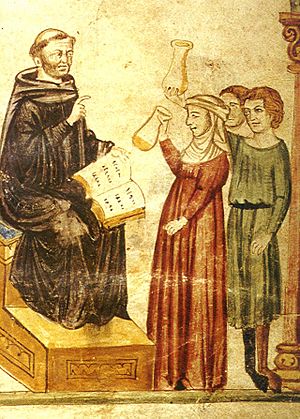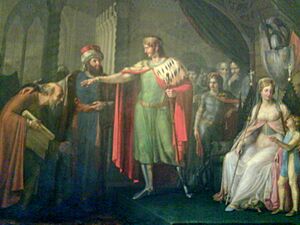Constantine the African facts for kids
Constantine the African (who lived in the 11th century) was a very important doctor. He was born in Ifriqiya (which is modern-day Tunisia and Algeria in North Africa) and later moved to Italy. He first arrived in Salerno, a city famous for its medical school called the Schola Medica Salernitana. His medical skills quickly caught the attention of the local rulers. Later, Constantine became a Benedictine monk and spent the last years of his life at the Monte Cassino abbey.
Constantine's first language was Arabic. He also spoke Greek, Latin, and other languages. He learned these skills during his many travels to places like Egypt, Syria, India, Ethiopia, and Persia. He was already very knowledgeable about medicine before he came to Salerno. In 1077, he joined the Monte Cassino abbey, south of Rome.
In Italy, Constantine created many important works. Most of these were translations of medical books from Arabic into Latin. He translated books by famous Arabic doctors like Razes, Ibn Imran, Ibn Suleiman, and Ibn al-Jazzar. These translated books are still kept in libraries across Europe today. They were used as textbooks for hundreds of years, from the Middle Ages until the 17th century.
Contents
Who Wrote About Constantine?
The first person to write about Constantine was a monk named Peter the Deacon in the 12th century. Peter said that Constantine was a Saracen, which was a term used for Muslims from North Africa back then. According to Peter, Constantine traveled to many distant lands, learning a lot about science. He then came to Monte Cassino because other people in Carthage were jealous of his knowledge.
Some historians have questioned Peter's story, saying it might be more of a legend. However, later historians like Salvatore de Renzi and Charles Daremberg used Peter's account. A German historian named Moritz Steinscheider wrote a whole book about Constantine in 1865. Later, another German medical historian, Karl Sudhoff, found new documents about Constantine's life. He published his findings in 1922, suggesting Constantine had a Berber-Islamic background.
Moving to Italy
According to Karl Sudhoff, Constantine first came to Italy as a merchant in Sicily. He then moved to Salerno. Because he didn't speak Italian, a doctor from North Africa named Abbas of Curiat helped him as an interpreter.
Constantine became ill and stayed with the king's brother, Gusulf. He noticed that the local doctors didn't seem very skilled. They didn't even ask for a urine sample, which was common practice. He also couldn't find any good Italian medical books. This made him realize that medicine in Italy was mostly based on simple, practical knowledge. He felt it was his mission to improve this.
After he got better, Constantine went back to Carthage in Ifriqiya. He practiced medicine there for three years and collected many important medical books. Then, he returned to southern Italy with his valuable collection. On his way to Salerno by boat, a storm damaged some of his manuscripts. He lost parts of a book by Ali Ibn Abbas Al Majoussi. When he arrived in Salerno with the remaining books, Constantine became a Christian. He then moved to Cassino and worked as an interpreter.
It's important to know that trade between North Africa and Italy was very active during this time. North Africa exported goods like olive oil, wax, leather, and wool. They imported wheat when needed. This trade continued even during difficult times.
His Important Medical Books

When Constantine arrived at Cassino, he brought many medical manuscripts from Tunis. These included works by famous doctors from Kairouan and Baghdad. Some of the important books he translated were:
- The book about sadness by Ishaq Ibn Imran.
- The book about pulse, urine, and diet by Ibn Ishaq Suleiman.
- The book "Zad Al Mussāfir" (which means "Traveler's Provisions" or "Viaticum") by Ahmed Ibn Al Jazzar.
- The book "Al Hawi" by Abu Bakr Al Razi.
- Parts of the book "Al Kamil" by Ali Ibn Al Abbas Al Majoussi. Constantine translated the first ten books, which were about medical theory. His translations of the next ten books, about medical practice, do not fully exist today.
These translations were incredibly important because they brought advanced Arabic medical knowledge to Europe.
The Legend of Constantine
Doctor Malgaigne wrote a famous story about Constantine. He said that Constantine was born in Carthage and had a strong desire to learn everything. He traveled to many places like Babylonia, India, and Egypt. He studied grammar, logic, medicine, math, astronomy, and music. After 40 years of travel and study, he returned home.
However, his own people were scared by how much he knew. They thought he was a sorcerer and banished him! Constantine found out in time and escaped. He went to Salerno and hid as a beggar for a while. A prince from Babylon recognized him and introduced him to the famous Robert Guiscard, a Norman ruler. Robert made Constantine his first secretary. But Constantine wanted to rest more than have honors. So, he left the court and went to Monte Cassino. There, he spent the rest of his life translating medical books from Arabic into Latin.
See also



